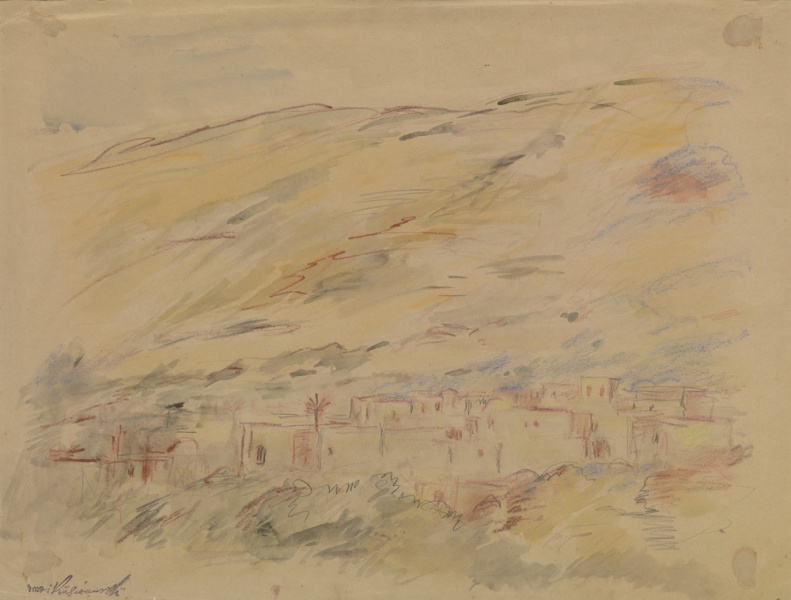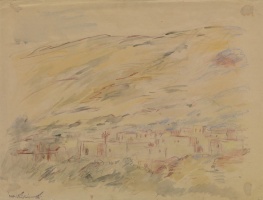
In Galilee Mountains
| Author: | Issai Kulvianski (1892–1970) |
Issai Kulvianski (b. 1892 Jonava – d. 1970 London) was born into a carpenter’s family in Jonava, and went to Vilnius in 1907 where he enrolled in the ORT School of Jewish Crafts, and from 1910 to 1912 he studied at the Vilnius School of Drawing. After travelling for a while between Paris and Berlin, he eventually settled in Berlin. During the First World War he was called up to serve in the Russian army and was captured by the Austrians. After the war he returned to Berlin. He was a member of the Bauhaus and the radical Novembergruppe. Kulvianski’s apartment was seized in 1933 when the Nazis came to power. Between 1933 and 1950, he lived in Israel, taught art at a private school, created scenery for the Habima Theatre in Tel Aviv, and organised exhibitions. His portrait of Antanas Smetona, the President of Lithuania, hung in a Lithuanian consulate in Israel, and he was commissioned to paint the portraits of King Hussein and King Abdullah of Jordan. In 1950 he returned to Europe and lived in the south of France, and later in southern Germany.
Source: Ellex Valiunas (LAWIN until 2015) art album: STORIES OF LITVAK ART (2023). Compiler and author Vilma Gradinskaitė.
Painter and teacher. Born on 24 October 1894 in Jonava, died in 1970 in London. In 1910–1911, he attended the Vilnius Drawing School. In 1912, he studied at the Berlin Art Academy under Hugo Kaufmann, Max Liebermann and Hermann Struck. In 1913, he moved to Paris and lived in La Ruche artists’ colony. In the years of World War I, he fought in the ranks of the Russian Army. In 1918, Kulvianski returned to Berlin and continued his studies under Leo von Koenig and Lovis Corinth, and was a member of the leftist artist group Novembergruppe. From 1927 to 1929, he taught drawing in various schools of Berlin and illustrated the newspaper Radio-Zeitung. In 1932, he visited Lithuania. From 1933 to 1950, he lived in Palestine, and in 1935, together with Georg Leschnitzer, founded a private art school there. Kulvianski was one of the founders of the Palestinian Painters’ and Sculptors’ Association. From 1950, he lived interchangeably in Val de Mersi in South France and Nuremberg, and from 1969 – in West Berlin. He painted landscapes, portraits and scenes of Jewish life. His early work displays the tendencies of expressionism, and later, features of Neue Sachlichkeit become manifest. He also created some realistic genre sculptures, and took part in exhibitions in Kaunas, Berlin and Tel Aviv.
Source: Académie de Vilna: Vilniaus piešimo mokykla 1866-1915 / Vilnius drawing school: Exhibition Catalogue, Nacionalinė dailės galerija 2017 m. 4 d. - lapkričio 26 d., compiled by Jolanta Širkaitė, Vilnius: Lietuvos kultūros tyrimų institutas, 2017, p. 250.

Issai Kulvianski (b. 1892 Jonava – d. 1970 London) was born into a carpenter’s family in Jonava, and went to Vilnius in 1907 where he enrolled in the ORT School of Jewish Crafts, and from 1910 to 1912 he studied at the Vilnius School of Drawing. After travelling for a while between Paris and Berlin, he eventually settled in Berlin. During the First World War he was called up to serve in the Russian army and was captured by the Austrians. After the war he returned to Berlin. He was a member of the Bauhaus and the radical Novembergruppe. Kulvianski’s apartment was seized in 1933 when the Nazis came to power. Between 1933 and 1950, he lived in Israel, taught art at a private school, created scenery for the Habima Theatre in Tel Aviv, and organised exhibitions. His portrait of Antanas Smetona, the President of Lithuania, hung in a Lithuanian consulate in Israel, and he was commissioned to paint the portraits of King Hussein and King Abdullah of Jordan. In 1950 he returned to Europe and lived in the south of France, and later in southern Germany.
Source: Ellex Valiunas (LAWIN until 2015) art album: STORIES OF LITVAK ART (2023). Compiler and author Vilma Gradinskaitė.
Painter and teacher. Born on 24 October 1894 in Jonava, died in 1970 in London. In 1910–1911, he attended the Vilnius Drawing School. In 1912, he studied at the Berlin Art Academy under Hugo Kaufmann, Max Liebermann and Hermann Struck. In 1913, he moved to Paris and lived in La Ruche artists’ colony. In the years of World War I, he fought in the ranks of the Russian Army. In 1918, Kulvianski returned to Berlin and continued his studies under Leo von Koenig and Lovis Corinth, and was a member of the leftist artist group Novembergruppe. From 1927 to 1929, he taught drawing in various schools of Berlin and illustrated the newspaper Radio-Zeitung. In 1932, he visited Lithuania. From 1933 to 1950, he lived in Palestine, and in 1935, together with Georg Leschnitzer, founded a private art school there. Kulvianski was one of the founders of the Palestinian Painters’ and Sculptors’ Association. From 1950, he lived interchangeably in Val de Mersi in South France and Nuremberg, and from 1969 – in West Berlin. He painted landscapes, portraits and scenes of Jewish life. His early work displays the tendencies of expressionism, and later, features of Neue Sachlichkeit become manifest. He also created some realistic genre sculptures, and took part in exhibitions in Kaunas, Berlin and Tel Aviv.
Source: Académie de Vilna: Vilniaus piešimo mokykla 1866-1915 / Vilnius drawing school: Exhibition Catalogue, Nacionalinė dailės galerija 2017 m. 4 d. - lapkričio 26 d., compiled by Jolanta Širkaitė, Vilnius: Lietuvos kultūros tyrimų institutas, 2017, p. 250.






